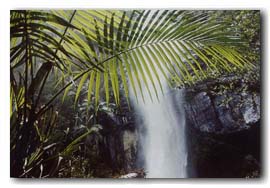
Dry rainforests occur where rainfall is low (600 - 1100 mm annually) and where there is a significant dry spell over spring so rainforest development can occur. They consist of a two tree stratum, with the upper being scattered emergents (Araucaria cunninhamii, Brachychiton discolor, Flindersia australis). The lower strata consists mainly of a dense layer which contains approximately 10 to 30 plant species. Leaves or leaflets are characteristically hard and small, usually less than 7.5 cm long. Woody vines and stranglers may be also commonly found. Other tropical features such as plank buttressing, palms and large epiphytes can be present but are rare. There is, however, a well developed, prickly shrub layer and a very sparse herbaceous ground cover.

Warm temperate rainforests are less diverse than subtropical and dry rainforests. There is commonly 3 to 15 plant species present which form a more uniform canopy of two strata. Most of the leaves are simple and many of them are toothed and ranging up to 12.5 cm long. This subformation occurs in cool, moist areas which favour lichens and ground ferns rather than large epiphyte ferns and orchids. Tropical features such as stranglers, palms, plank buttresses and woody vines are rare or absent.
Cool temperate rainforests can be defined as a floristically simple forest with only one to three common tree species. These species generally form a single (sometimes two-layered) canopy of dense, even and uniform height. Most of the species have simple, toothed leaves which are less than 7.5 cm long. There is one common exception (Eucryphia moorei) which has compound and entire leaves. This rainforest occurs in cool, reliably moist areas such as those along the coastal escarpment where mists are frequent. These moist conditions favour the characteristic development of a dense growth of mosses and lichens on tree trunks and branches as well as a moist ground layer of ferns and tree ferns.

